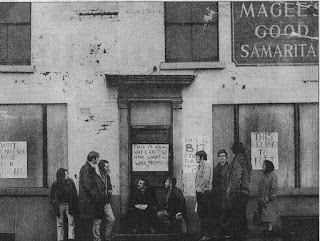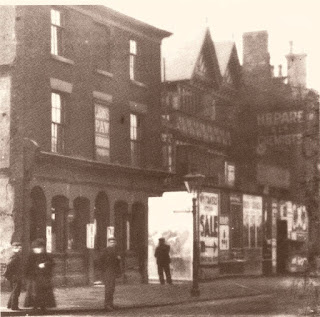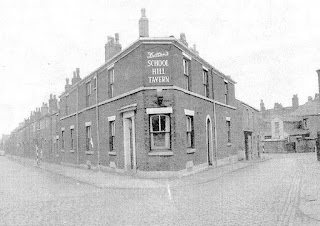The bottom end of Derby Street pictured in September 2014 (copyright Google Street View). Fletcher Street can be sign on the left. Direct entry onto Derby Street ended in 1980 when the road was re-routed to traverse the former Pilkington Street to meet the main road at College Way. The Good Samaritan was directly where the entrance to KFC now stands.
The Good
Samaritan was on Derby Street not far from the corner of Fletcher Street. The pub dated back to the 1840s. Isaac Maude is listed as the landlord on the 1843
Bolton Directory. He was a brewer living on Kay Street in 1841 and appears to
have moved to the beerhouse shortly afterwards.
An
early landlord was David Magee who was at the Good Samaritan from 1855 until
1866. Magee is believed to have been born in Scotland and his name was originally spelled McGee. He was in Bolton by 1841
living with the Forrest family in Shuttle Street. By 1851 he was in Coe Street working as a weaver before turning to the beer trade.
Like many pub landlords of the time Magee was also a brewer, but his ambitions were greater than just to brew for his own pub and when he moved further up Derby Street to the Crown Hotel it was because the spare land next to the pub enabled him to build a much larger brewery.
Like many pub landlords of the time Magee was also a brewer, but his ambitions were greater than just to brew for his own pub and when he moved further up Derby Street to the Crown Hotel it was because the spare land next to the pub enabled him to build a much larger brewery.
Magee
died in 1875 and it was left to his three sons, Thomas, John and Joseph, to
turn Magee, Marshall and Co, as the business was eventually known, into a
substantial local enterprise.
By
the mid-1870s George Crompton was the landlord. However, he went off to work
for Magee’s where he became one of the brewery’s manager. Samuel Pye succeeded
Crompton and was at the pub until his death in 1896.
The
Good Samaritan remained as a Magee’s pub even after David Magee's departure and
it formed part of the sale of Magee, Marshall & Co’s to Greenall, Whitley
in 1958.
Much
of the area bordered by Derby Street, Fletcher Street, Houghton Street and
Pilkington Street was redeveloped in the late-sixties and early-seventies.
The Good Samaritan closed in 1969 by which time it had developed something of a bad reputation. It was demolished shortly afterwards but not until after it had been the subject of a protest from students at Bolton Institute of Technology which had just been built across the road. The students claimed to have been promised a union bar and the BIT authorities had reneged on the promise. They pointed at the now empty Good Samaritan as an ideal venue for the union (see photo below).
In the end, the authorities granted the students an area inside the main BIT building for their bar. They were also given permission to use the refectory for gigs. During the seventies, the BIT Students Union put on concerts by the likes of Motorhead, the Scorpions and the Crazy World Of Arthur Brown. The Sex Pistols' infamous gig at the Lesser Free Trade Hall in Manchester in June 1976 had been scheduled to take place at the BIT until the union got cold feet. It's unlikely that any of those gigs could have taken place in the back room of the Good Samaritan.
The Good Samaritan closed in 1969 by which time it had developed something of a bad reputation. It was demolished shortly afterwards but not until after it had been the subject of a protest from students at Bolton Institute of Technology which had just been built across the road. The students claimed to have been promised a union bar and the BIT authorities had reneged on the promise. They pointed at the now empty Good Samaritan as an ideal venue for the union (see photo below).
In the end, the authorities granted the students an area inside the main BIT building for their bar. They were also given permission to use the refectory for gigs. During the seventies, the BIT Students Union put on concerts by the likes of Motorhead, the Scorpions and the Crazy World Of Arthur Brown. The Sex Pistols' infamous gig at the Lesser Free Trade Hall in Manchester in June 1976 had been scheduled to take place at the BIT until the union got cold feet. It's unlikely that any of those gigs could have taken place in the back room of the Good Samaritan.




















